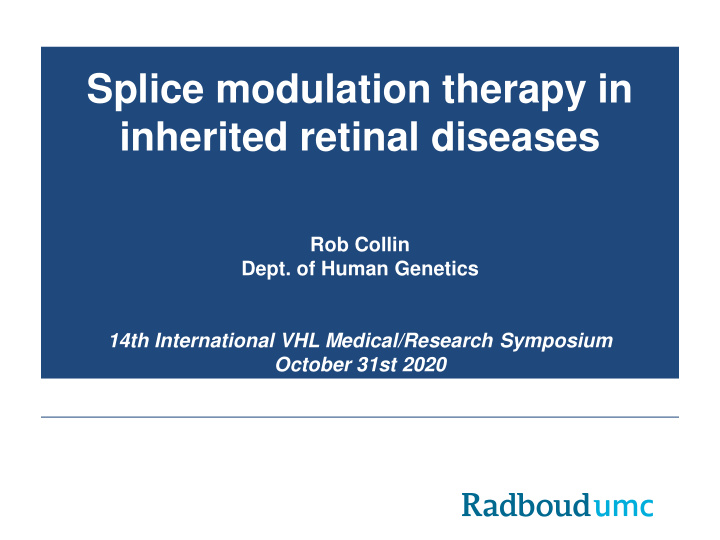



Splice modulation therapy in inherited retinal diseases Rob Collin Dept. of Human Genetics 14th International VHL Medical/Research Symposium October 31st 2020
The eye and inherited retinal diseases (IRDs)
Clinical and genetic heterogeneity of IRD Clinical heterogeneity Stargardt Cone- disease rod Genetic heterogeneity dystrophy Age Retinitis pigmentosa Cone dystrophy ACHM Leber congenital amaurosis
Clinical and genetic heterogeneity of IRD Clinical heterogeneity Stargardt Cone- disease rod Genetic heterogeneity dystrophy Age Retinitis pigmentosa Cone dystrophy ACHM Leber congenital amaurosis
Leber congenital amaurosis (LCA)
Clinical features of LCA • Severe and early visual loss (< 12 months) • Sensory nystagmus • Subnormal or absent electrical signals on electroretinogram (ERG) • Amaurotic pupils • Franceschetti's oculo-digital sign Nystagmus Oculo-digital sign Amaurotic pupils
CEP290 -associated LCA CEP290 is a ‘ciliary’ protein that has a specific role in the assembly and maintenance of the (connecting) cilium, in many different (ciliated) cells
CEP290 -associated LCA den Hollander et al. (2006), Am J Hum Genet
Aberrant splicing of CEP290 LCA-causing mutation c.2991+1655A>G CEP290 DNA Transcription CEP290 pre-mRNA Splicing CEP290 mRNA ~50% Incorrect CEP290 ~50% Correct CEP290
AON-based therapy for CEP290 -associated LCA LCA-causing mutation c.2991+1655A>G CEP290 DNA Transcription AON binding GGGUCAACAUUAACACUCAUA CEP290 pre-mRNA Splicing CEP290 mRNA 100% Correct CEP290
AON-based therapy for CEP290 -associated LCA Design AONs Assess AON effect in cultured lymphoblasts from patients Collin et al. (2012), Mol Ther Nuc Acids
AON-therapy: ‘naked’ or ‘viral’ ? Naked AON AAV-AON 3’-GGGUCAACAUUAACACUCAUA-5’ Pro’s: - single surgery Pro’s: - ‘easy’ delivery - long-term expression - no permanent expression - adjusting dose possible Cons: - side-effects persistent - partially reaching retina Cons: - life long injections
Rescue in fibroblasts: RNA level Garanto et al. (2016), Hum Mol Genet
Rescue in fibroblasts: protein level *p-value<0.05 **p-value<0.01 ***p-value<0.001 Protein levels are significantly increased after AON treatment Garanto et al. (2016), Hum Mol Genet
Rescue in fibroblasts: ciliation level
The iPSC – retinal organoid model Parfitt et al. (2016), Cell Stem Cell
QR-110 in iPSC-derived retinal organoids Dulla et al. (2018), Mol Ther Nucleic Acids
QR-110 in iPSC-derived retinal organoids Dulla et al. (2018), Mol Ther Nucleic Acids
Results of a phase I/II clinical trial
Stargardt disease (STGD1)
Clinical features of STGD1 • Progressive disorder, mainly affecting central vision • Variable age of onset and disease course • Characterized by ‘flecks’ on autofluorescence imaging • Caused by bi-allelic mutations in ABCA4
ABCA4 ABCA4 protein dysfunction leads to accumulation of waste products (lipofuscin)
Finding genetic causes of STGD1 In 25-30% of STGD1 cases, no or only one ABCA4 allele could be detected 4,000 smMIPs for 128-kb ABCA4 gene 1 10 20 30 40 50 20-nt annealing primers 30-nt linker 110 nt Exon X
Deep-intronic variants in ABCA4 Mutation Position c.769-784C>T Intron 6 c.859-540C>G Intron 7 c.859-506G>C Intron 7 c.1937+435C>G Intron 13 1. Are these deep-intronic c.4253+43G>A Intron 28 variants affecting pre-mRNA splicing, and if so, how? c.4539+1100A>G Intron 30 c.4539+1106C>T Intron 30 2. Can we do something about it? c.4539+2001G>A Intron 30 c.4539+2028C>T Intron 30 c.4539+2064C>T Intron 30 c.5197-557G>T Intron 36 ............ .............
Deep-intronic variants in ABCA4 Mutation Position c.769-784C>T Intron 6 c.859-540C>G Intron 7 c.859-506G>C Intron 7 c.1937+435C>G Intron 13 1. Are these deep-intronic c.4253+43G>A Intron 28 variants affecting pre-mRNA splicing, and if so, how? c.4539+1100A>G Intron 30 c.4539+1106C>T Intron 30 2. Can we do something about it? c.4539+2001G>A Intron 30 c.4539+2028C>T Intron 30 c.4539+2064C>T Intron 30 c.5197-557G>T Intron 36 ............ .............
Splicing modulation for Stargardt disease A high-throughput assay (c.859-506G>C) Transfection Variant of interest RHO RHO exon 3 exon 5 7 8 9 10 11 HEK293T cells RT-PCR analysis Sangermano, Garanto, Khan et al. (2019), Genet Med
Splicing modulation for Stargardt disease Midigene Sangermano, Garanto, Khan et al. (2019), Genet Med
Splicing modulation for Stargardt disease Midigene Fibroblasts However, n=1 Sangermano, Garanto, Khan et al. (2019), Genet Med
Splicing modulation for Stargardt disease But sometimes…… M1 M2 M1: c.4539+2001G>A M2: c.4539+2028C>T Albert, Garanto et al. (2018), Am J Hum Genet
Splicing modulation for Stargardt disease But sometimes…… M1 M2 M1: c.4539+2001G>A M2: c.4539+2028C>T Albert, Garanto et al. (2018), Am J Hum Genet
Splicing modulation for Stargardt disease Garanto et al. (2019), Genes
Where are we now ? Preclinical Discovery Clinical testing development Lead Lead Clin. trial Clin. trial Clin. trial Idea GLP / Tox discovery optimiz. phase 1 phase 2 phase 3 CEP290 -associated LCA ABCA4 -associated IRD Other approaches (genome editing / gene augmentation)
To summarize • AON-based therapy is a promising therapeutic approach for IRD • AONs unfortunately are only applicable to a subset of mutations • The (ultra)rarity of some variants requires creative solutions wrt clinical trial setup
Acknowledgements Collin & Garanto Lab Alex Garanto Lonneke Duijkers Tomasz Tomkiewicz Nuria Suarez Herrera Irene Vazquez Dominguez Tess Afanasyeva Manon Peeters Anita Hoogendoorn RadboudUMC Silvia Albert Ghent, Ghent University New York, Columbia Riccardo Sangermano Miriam Bauwens Rando Allikmets Mubeen Khan Elfride de Baere Winston Lee Frans Cremers Sarah Naessens Philadelphia, Scheie Eye Nathalie Bax London, UCL Institute Carel Hoyng Michael Cheetham Jean Bennett Saskia van der Velde-Visser David Parfitt Daniel Chung Dyon Valkenburg Jeroen Klevering ProQR Therapeutics Rotterdam, REH Peter Adamson Ingeborgh van den Born Boston, Mass Eye and Ear Kalyan Dulla Luk Vandenberghe Jim Swildens Ru Xiao Gerard Platenburg
Recommend
More recommend